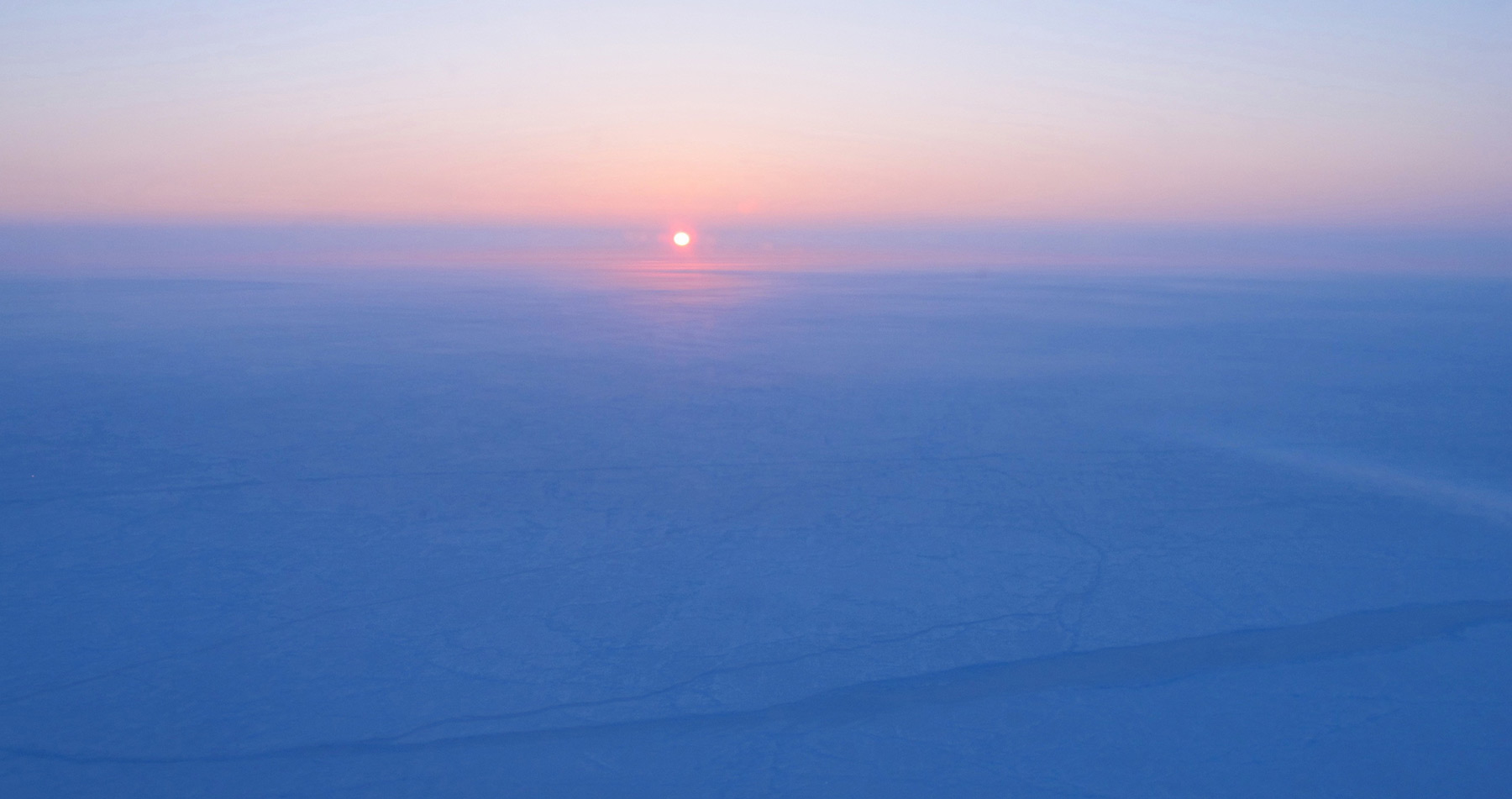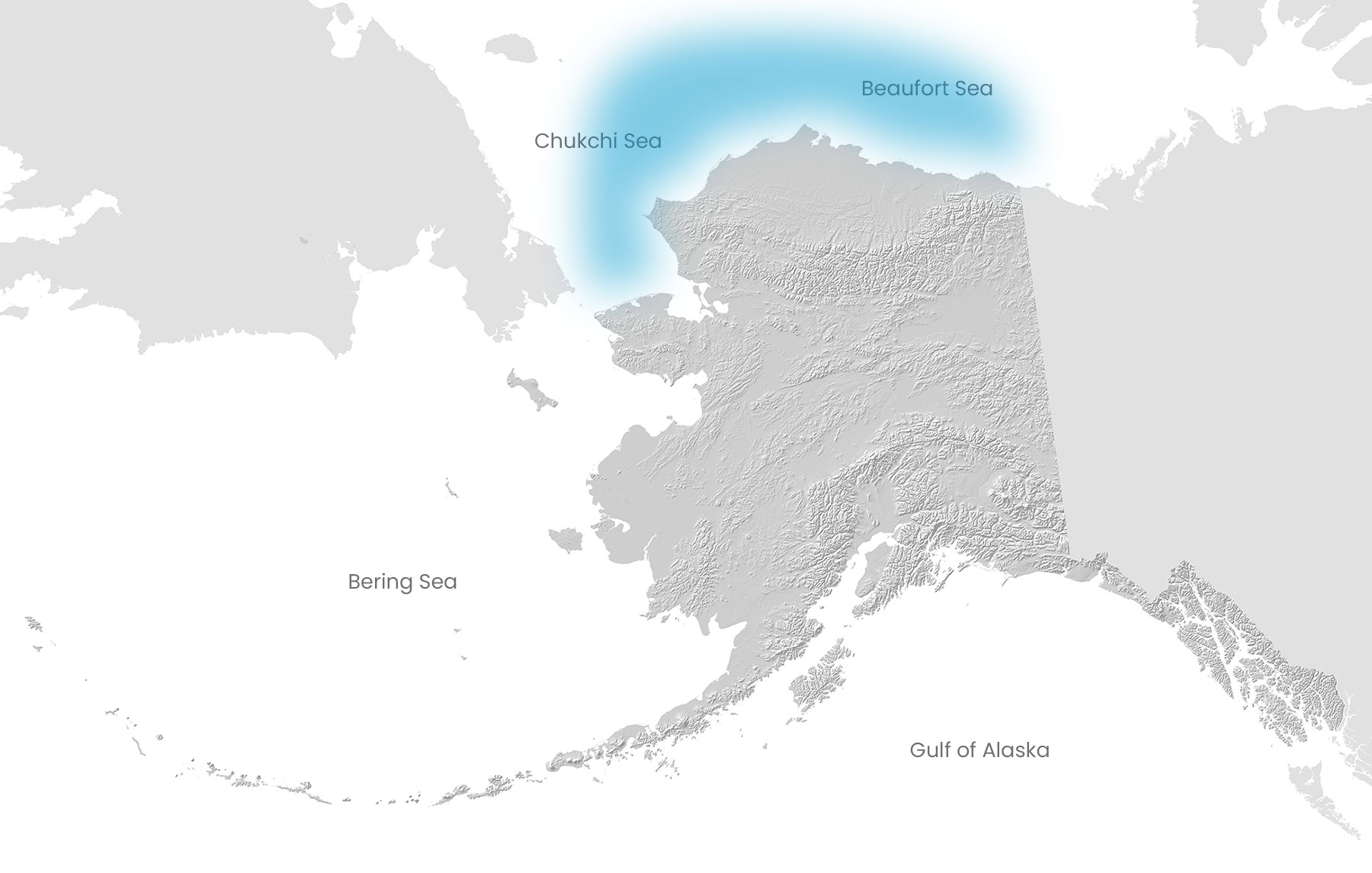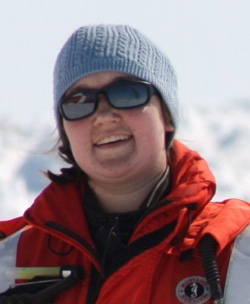Arctic

Changes in sea ice cover, water temperature, and timing and frequency of storms are influencing factors in the rate of ocean acidification in the Arctic. Photo by NASA.
What We Know
The cold, naturally carbon rich waters of the Chukchi and Beaufort Seas make the waters off Arctic Alaska particularly vulnerable to ocean acidification. This has traditionally been a hard place to monitor due to its remoteness, hazardous environment for sensors and researchers, and the presence of sea ice for much of the year. What we know now is primarily from computational models with limited data from research cruises, autonomous vehicles, and several mooring deployments.
Chukchi Sea
Ocean acidification in the Chukchi Sea is strongly influenced by sea ice. As sea ice changes over time, including shifts towards a longer ice-free season, reduced sea ice thickness and reduced sea ice coverage, Chukchi Sea waters may experience more corrosive surface waters. This is in part because sea ice melt can be mildly corrosive, but also because sea ice controls the amount of atmospheric CO2 taken up by the oceans. Less sea ice cover may mean that the Chukchi Sea absorbs more carbon dioxide and acidifies faster.
Another factor affecting the carbon chemistry of the Chukchi is the “biological pump”. This occurs when carbon dioxide is removed from the surface water by marine plants (like phytoplankton). When these marine plants die and sink to the bottom, bacterial respiration releases the CO2 from the plant matter, causing some subsurface CO2 buildup and corresponding acidification. This same process happens in the Bering Sea.
Wind also plays a role in carbon chemistry in the Chukchi Sea. As climate change intensifies, summer wind speed is strengthening. More frequent mixing of the water column resulting from stronger winds and storms can bring colder and older — and more acidified — waters to the surface, which can reach important shallow habitats.
Chukchi and Beaufort Regional Profile
The Chukchi Sea is a portion of the Arctic Ocean bounded on the west by the Long Strait, off of Wrangell Island, and in the east by Point Barrow, Alaska. The Beaufort Sea continues east along the north slope of Alaska. These are the traditional waters of Iñupiat indigenous peoples. Many subsistence fishers operate gillnets in the coastal marine waters of the Arctic Ocean to harvest marine and freshwater finfish including chum, pink, and Chinook salmon, Arctic cisco, broad whitefish, Dolly Varden, and Arctic Grayling. Communities also harvest marine mammals such as bearded seal, walrus, and bowhead whales, as well as seabirds and seabird eggs. Some small scale commercial fishing for chum salmon takes place in Kotzebue Sound. Since around 1990, commercial fishing for Arctic cisco and least cisco have occurred in October and November, using set gillnets operated under the ice.
Photo Gallery
↓Click to enlarge↓
A recent data synthesis based on 30 years of data collected from the Chukchi Sea shelf shows that the intensity and frequency these ocean acidification “events” are increasing in the Arctic. While the Chukchi seawater chemistry is currently still favorable for shell builders (‘supersaturated’ for aragonite), it is expected to be corrosive for shell builders by 2050 (‘undersaturated’ for aragonite).
Beaufort Sea
The Beaufort Sea is a narrow basin with fewer nutrients and a much lower rate of biological production than other Alaskan waters. The main driver of carbon chemistry is upwelling – deep water coming to the surface that is naturally high in CO2 and corrosive to shell-builders (undersaturated in aragonite). In one upwelling event observed by researchers, these waters came to the surface and moved all the way inshore along the Beaufort shelf, covering thousands of square kilometers.
In the past, upwelling diminished in fall each year when sea ice returned, however now that sea ice is consistently forming or arriving later, the surface is increasingly open during late autumn storms. This allows the upwelling process to continue and intensify, which exacerbates ocean acidification. According to Mathis et al (2015), “In the future, the Beaufort shelf is likely to be persistently, if not continually, exposed to waters that are under-saturated with respect to aragonite as sea ice cover continues to diminish under warming conditions.”
What We Know About the Chukchi and Beaufort Seas and OA
The Chukchi Sea is a portion of the Arctic Ocean bounded on the west by the Long Strait, off of Wrangel Island, and in the east by Point Barrow, Alaska. The Beaufort Sea continues east along the north slope of Alaska. These are the traditional waters of Iñupiat, Yup’ik, Unangan, and Chukchi indigenous peoples. Many subsistence fishers operate gillnets in the coastal marine waters of the Arctic Ocean to harvest marine and freshwater finfish including chum, pink, and Chinook salmon, Arctic cisco, broad whitefish, Dolly Varden, and Arctic Grayling. Commercial fishing efforts are limited due to seasonal sea ice cover. Since around 1990, commercial fishing for Arctic cisco and least cisco have occurred in October and November, using set gillnets operated under the ice.
Chukchi Sea
Ocean acidification in the Chukchi Sea is strongly influenced by sea ice. As sea ice changes over time, including shifts towards a longer ice-free season, reduced sea ice thickness and reduced sea ice coverage, Chukchi Sea waters may experience more corrosive surface waters. This is in part because sea ice melt can be mildly corrosive, but also because sea ice controls the amount of atmospheric CO2 taken up by the oceans. Less sea ice cover may mean that the Chukchi Sea absorbs more carbon dioxide and acidifies faster.
Another factor affecting the carbon chemistry of the Chukchi is the “biological pump”. This occurs when carbon dioxide is removed from the surface water by marine plants (like phytoplankton). When these marine plants die and sink to the bottom, bacterial respiration releases the CO2 from the plant matter, causing some subsurface CO2 buildup and corresponding acidification. This same process happens in the Bering Sea.
Wind also plays a role in carbon chemistry in the Chukchi Sea. As climate change intensifies, summer wind speed is strengthening. More frequent mixing of the water column resulting from stronger winds and storms can bring colder and older — and more acidified — waters to the surface, which can reach important shallow habitats. A recent data synthesis based on 30 years of data collected from the Chukchi Sea shelf shows that the intensity and frequency these ocean acidification “events” are increasing in the Arctic. While the Chukchi seawater chemistry is currently still favorable for shell builders (‘supersaturated’ for aragonite), it is expected to be corrosive for shell builders by 2050 (‘undersaturated’ for aragonite).
Beaufort Sea
The Beaufort Sea is a narrow basin with fewer nutrients and a much lower rate of biological production than other Alaskan waters. The main driver of carbon chemistry is upwelling – deep water coming to the surface that is naturally high in CO2 and corrosive to shell-builders (undersaturated in aragonite). In one upwelling event observed by researchers, these waters came to the surface and moved all the way inshore along the Beaufort shelf, covering thousands of square kilometers.
In the past, upwelling diminished in fall each year when sea ice returned, however now that sea ice is consistently forming or arriving later, the surface is increasingly open during late autumn storms. This allows the upwelling process to continue and intensify, which exacerbates ocean acidification. According to Mathis et al (2015), “In the future, the Beaufort shelf is likely to be persistently, if not continually, exposed to waters that are under-saturated with respect to aragonite as sea ice cover continues to diminish under warming conditions.”
Chukchi and Beaufort Regional Profile
The Chukchi Sea is a portion of the Arctic Ocean bounded on the west by the Long Strait, off of Wrangel Island, and in the east by Point Barrow, Alaska. The Beaufort Sea continues east along the north slope of Alaska. These are the traditional waters of Iñupiat, Yup’ik, Unangan, and Chukchi indigenous peoples. Many subsistence fishers operate gillnets in the coastal marine waters of the Arctic Ocean to harvest marine and freshwater finfish including chum, pink, and Chinook salmon, Arctic cisco, broad whitefish, Dolly Varden, and Arctic Grayling. Commercial fishing efforts are limited due to seasonal sea ice cover. Since around 1990, commercial fishing for Arctic cisco and least cisco have occurred in October and November, using set gillnets operated under the ice.
Photo Gallery
↓Click to enlarge↓
Recent Studies
Since 2016, researchers have deployed sensors on a mooring at the southern tip of Hannah Shoal that includes measurements of acidity and CO2 in the water. This data has shown that the CO2 content in the water is highly variable from year to year and is mainly driven by the timing of sea ice retreat and big storm systems.
Researchers are also developing a computational model to help identify and track the forces that may exacerbate or mitigate ocean acidification in these regions. In addition, the model is being used to track conditions backwards in time in order to understand how they have changed since 2015. This information provides context for understanding the range in water conditions that marine organisms have previously experienced compared to what they may be experiencing now and in the near future. This will help us make better predictions about how climate change and sea-ice loss may affect future CO2 concentrations and ocean acidification in the Arctic.
Rapid acidification of the Arctic Chukchi Sea Waters: Qi et al 2022
- Researchers present a 17-year (2002–2019) observational data set in the Chukchi Sea to determine the long-term changes in pH and aragonite saturation state (Ωarag).
Results
- pH and Ωarag declined in different water masses with average rates of −0.0047 ± 0.0026 years−1 and −0.017 ± 0.009 years−1, respectively.
- Rapid acidification is attributed to the increased dissolved inorganic carbon owing to a combination of ice melt-induced increased atmospheric CO2 invasion and subsurface remineralization induced by a stronger surface biological production as a result of the increased inflow of the nutrient-rich Pacific water.
Summer surface CO2 dynamics on the Bering Sea and Eastern Chukchi Sea shelves from 1989 to 2019: Wang et al 2022
Summer surface CO2 dynamics on the Bering Sea and Eastern Chukchi Sea shelves from 1989 to 2019: Wang et al 2022
- Researchers compiled boreal summer (June to October) surface CO2 measurements from 1989 to 2019 on the Bering and eastern Chukchi Sea shelves.
Results
- The study areas act as a CO2 sink except when impacted by river runoff and wind-driven upwelling.
- The CO2 system in this area is seasonally dominated by the biological pump especially in the northern Bering Sea and near Hanna Shoal, while wind-driven upwelling of CO2-rich bottom water can cause episodic outgassing.
- In the northern Chukchi Sea, rapid warming concurrent with reduced seasonal sea-ice persistence caused a long-term decrease in the regional summer CO2 sink.
- Increasing primary productivity caused the regional summer CO2 sink on the Bering Sea shelf to increase over time.
Sea-ice loss amplifies summertime decadal CO2 increase in the western Arctic Ocean: Ouyang et al., 2020
Sea-ice loss amplifies summertime decadal CO2 increase in the western Arctic Ocean: Ouyang et al., 2020
- Researchers compiled new sea surface 𝑝CO2 data together with historical data from multiple international databases from 1994 to 2017, including data from the Chukchi and Beaufort Seas.
Results
- 1994–2017, summer 𝑝CO2 in the Canada Basin increased at twice the rate of atmospheric increase, due to Warming and ice loss
- This may result in the Canada Basin sink for CO2 to fill up, and not be able to absorb additional CO2 from the atmosphere
- In the Chukchi Sea, the CO2 sink has increased and may increase further due to biological production and unique biogeochemical processes
Formation and transport of corrosive water in the Pacific Arctic region: Cross et al., 2018
Formation and transport of corrosive water in the Pacific Arctic region: Cross et al., 2018
- Researchers synthesized sub-surface data from multiple studies to explore the sub-surface carbon system in the Chukchi and Beaufort Seas.
Results
- In the Chukchi Sea, formation of corrosive conditions in colder, denser winter-modified Pacific waters occurs over shallow shelves, resulting from the combination of seasonal terrestrial and marine organic matter respiration with anthropogenic CO2.
- When these waters are subsequently transported off the shelf, they acidify the Pacific halocline.
- Upwelling events along the Beaufort Sea shelf bring Pacific halocline waters to the ocean surface, where the loss of CO2 during these events can eliminate corrosive conditions in the upwelled Pacific halocline waters.
- Potentially corrosive subsurface Pacific waters are present in the Beaufort shelf break jet during 80% of the year, indicating that the persistence of acidified waters in the Pacific halocline far outweighs any seasonal mitigation from upwelling.
- Persistent corrosivity of the Pacific halocline is a recent phenomenon that appeared between 1975 and 1985.
Additional papers
Sea-air CO2 exchange in the western Arctic coastal ocean: Evans et al 2015
Ocean Acidification in the Surface Waters of the Pacific-Arctic Boundary Regions: Mathis et al 2015
Storm-induced upwelling of high pCO2 waters onto the continental shelf of the western Arctic Ocean and implications for carbonate mineral saturation states: Mathis et al 2012
Implications
Current research shows that climate change can impact CO2 uptake by changing ocean temperatures and ocean plant activity, but it is unclear if these changes are permanent or temporary. It will take multiple decades of pCO2 measurements to detect the ocean acidification long-term trend in this highly dynamic and variable system.
Researchers
Stories
May 2016
Anchorage Daily News








